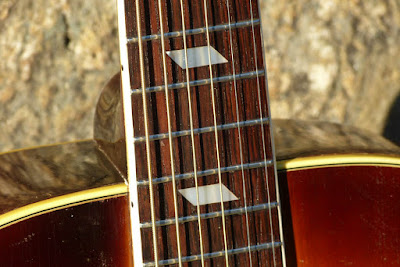1941 Epiphone FT-75 Jumbo Flattop Guitar
Hoooo-eee this is a grown man's guitar! If we can call a Gibson J-45 a "slope dread" then this is a "dread" as well, though the "super 000 plus dreadnought" body shape recalls later 60s Harmony Sovereign jumbos to my eye. This one has a body length and bulk (16 1/4" across the lower bout) that's on par with a J-45 but the waist sits higher. Add to that a longer scale (25 1/2") and you have a very different feel in the lap -- though the target audience seems to be the same. Wouldn't this make a proud "old country" chord-banger?
All that aside, the most interesting feature -- perhaps -- is the tailpiece-loaded bridge which both engages a "flattop" tonal mode in the way the down-pressure "tie block" on the rear of it loads tension and also a "tailpiece" mode in the way the strings have less full-on sideways pressure on the top. Is it a surprise the top is thus in belly-free, excellent shape? This style of string loading is actually very popular for guitar-like instruments throughout Latin America, Spain, Portugal, and culturally-related countries but is very, very uncommon in the US of A. Epiphone (at this point still the original New York company) must have been trying to solve the continual frustration of steel strings and pin-bridge "pull up" that haunts the American guitar in general -- as this tailpiece load is original equipment!
My opinion is that they succeeded: the top on this is x-braced and could probably handle direct tension from strings rear-loaded on that bridge just as she is right now -- but why? It sounds amazingly good the way it's setup at the moment and will be far more stable left this way. Look at how well it's survived for proof: big tall saddle, no top problems, all ship-shape! Tone is gutsy, full, loud, and very "big x-braced flattop" in nature but with that singular Epi punch thrown in.
The story on this guitar is that a customer bought this and sent it to me for work before grabbing it himself. Upon hearing of its 1 13/16" nut width he decided to part ways with it instead. His loss!
I had some time left at the end of the day today and gave it what it needed: a fret level/dress, adjustments to the saddle, cleaning, and a decent setup with a set of 12s. As stated before: this thing is all business -- big, round, punchy sound. I'm a bit in love.
Everything is original on this guitar save that newer bone nut and perhaps the saddle... and check out the lovely condition of the finish and all those little "extra details." I like that little metal truss-rod cover with the micro-micro screws and that precisely-cut pearl script. The truss works perfectly, by the way.
The nut width, as said, is 1 13/16" with a mild radius to the rosewood board. The neck itself has a mild C/D shape which is very comfortable in an old-timey sort of way. I enjoy the extra side-side space for fingerpicking, that's for sure.
The pearl markers are classic Epi.
I love the look of this guitar... it's so deco and yet so cowboy.
Nice bridge, huh?
Intonation is excellent (especially now that the B slot is compensated).
Here's the biggest trick to loading the strings successfully: when this came in the strings were loaded "normally" (for an archtop guitar) with the ball-ends at the back. This meant that under tension the strings pulled the tailpiece right down onto the top. A better way to do this is load it backwards and "fold" the strings under the back edge of the tailpiece bar. This pulls the tailpiece up and off the top and also lets you fit a bit of muting foam under the bottom of the tailpiece to mute the string afterlength (if desired) and thus clear up overtones.
Seriously -- with the tailpiece bar resting on the top the perceived volume was cut by perhaps 1/4 or so. It's much more robust without it acting as a mute -- though I suppose that's a fairly obvious observation.
The top is solid spruce and the guitar is entirely crack-free save a 3 1/2" glued-up hairline on the back. The finish is also in great shape save the usual weather-checking and a few light scratches here and there.
The back and sides are solid figured maple -- flamed stuff for the sides and curly stuff for the back.
The original deco-style Epi tuners still work great.
I'm not sure if this had a neck reset in the past but the angle is great. Note that the neck is a nice hunk of mahogany.
Here you can get an idea of the practicality of this design.
Ironically, boutique modern luthiers are now building more guitars with the same setup and it's become a relatively common thing to see in the classical guitar community.
The serial plops this right down at 1941.
I also can't complain about a blue-lined, arched hard case...!

























Comments
Yours
Drew